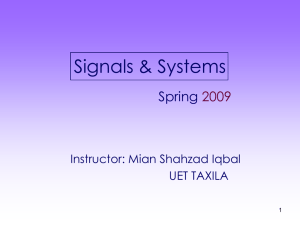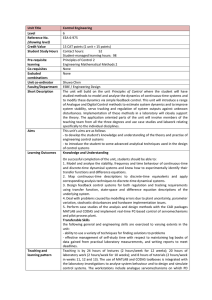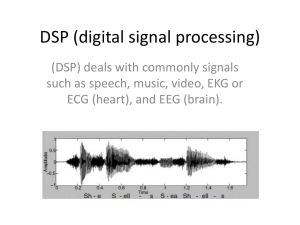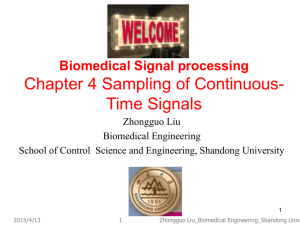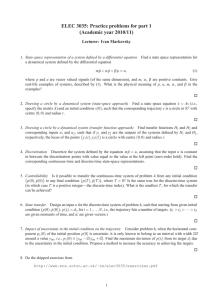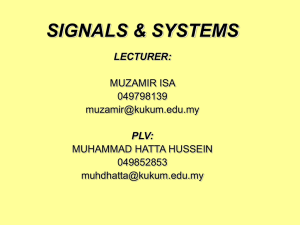the many faces of frequency 6 - University of California, Berkeley
advertisement
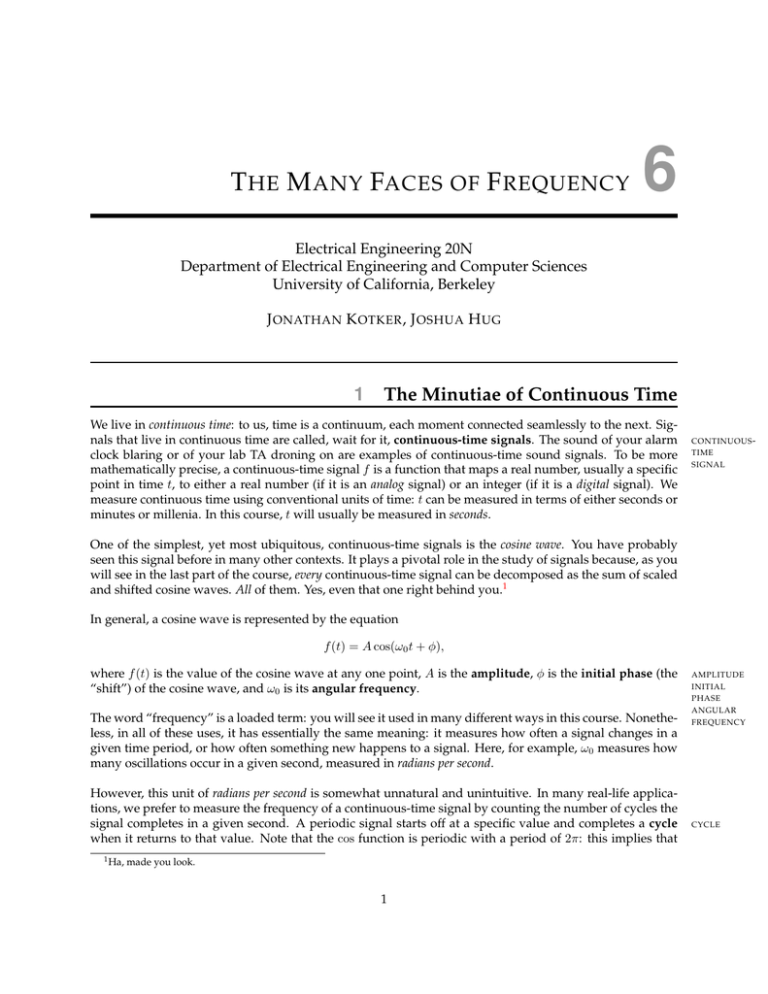
T HE M ANY FACES OF F REQUENCY 6 Electrical Engineering 20N Department of Electrical Engineering and Computer Sciences University of California, Berkeley J ONATHAN K OTKER , J OSHUA H UG 1 The Minutiae of Continuous Time We live in continuous time: to us, time is a continuum, each moment connected seamlessly to the next. Signals that live in continuous time are called, wait for it, continuous-time signals. The sound of your alarm clock blaring or of your lab TA droning on are examples of continuous-time sound signals. To be more mathematically precise, a continuous-time signal f is a function that maps a real number, usually a specific point in time t, to either a real number (if it is an analog signal) or an integer (if it is a digital signal). We measure continuous time using conventional units of time: t can be measured in terms of either seconds or minutes or millenia. In this course, t will usually be measured in seconds. CONTINUOUS TIME SIGNAL One of the simplest, yet most ubiquitous, continuous-time signals is the cosine wave. You have probably seen this signal before in many other contexts. It plays a pivotal role in the study of signals because, as you will see in the last part of the course, every continuous-time signal can be decomposed as the sum of scaled and shifted cosine waves. All of them. Yes, even that one right behind you.1 In general, a cosine wave is represented by the equation f (t) = A cos(ω0 t + φ), where f (t) is the value of the cosine wave at any one point, A is the amplitude, φ is the initial phase (the “shift”) of the cosine wave, and ω0 is its angular frequency. The word “frequency” is a loaded term: you will see it used in many different ways in this course. Nonetheless, in all of these uses, it has essentially the same meaning: it measures how often a signal changes in a given time period, or how often something new happens to a signal. Here, for example, ω0 measures how many oscillations occur in a given second, measured in radians per second. However, this unit of radians per second is somewhat unnatural and unintuitive. In many real-life applications, we prefer to measure the frequency of a continuous-time signal by counting the number of cycles the signal completes in a given second. A periodic signal starts off at a specific value and completes a cycle when it returns to that value. Note that the cos function is periodic with a period of 2π: this implies that 1 Ha, made you look. 1 AMPLITUDE INITIAL PHASE ANGULAR FREQUENCY CYCLE a cycle is equivalent to 2π radians. If we count the number of cycles the cosine wave completes in one second—call this value f0 —and multiply it by 2π, the result should be ω0 . To summarize, ω0 = 2πf0 , and so f (t) = A cos(ω0 t + φ) = A cos(2πf0 t + φ). f0 , as you may guess, is measured in cycles per second, which is otherwise known as Hertz (Hz). This is the quantity that we use to measure sounds in. For example, musicians define the note A to be the sinusoidal sound wave with frequency 440 Hz; bats interact with the world using sounds at frequencies in the range 20kHz to 100kHz; and the human ear can detect sounds in the frequency range from 20Hz to 20kHz. Both ω0 and f0 are described as the continuous-time frequency of the signal, and context and units determine which specific quantity is being referred to. CONTINUOUS TIME FREQUENCY For simplicity, for the rest of the document, we will refer to our exemplar continuous-time cosine wave as fC (t) with no initial phase. Then, fC (t) = A cos(ω0 t). 2 Sampling Matters become interesting when we attempt to store continuous-time signals on our computers. This attempt has many motivations: perhaps the most relevant is that we want to store a signal on our computers, where we can easily work on the signal. The manipulation of signals using computers and computer-based devices is at the crux of digital signal processing. However, we have one major issue: continuous-time signals have an uncountably infinite set of values, while computers can only store a finite set of values: there are far, far more “time points” in the period from now until the next second than can ever be stored on any computer. We do the next best thing: we sample the continuous-time signal to produce the corresponding discretetime signal, as shown in Figure 1. Figure 1 Sampling a continuous-time signal to produce a discrete-time signal. As the figure implies, when we sample a continuous-time signal, we record the value of the continuoustime signal at equally spaced time points. Each such recorded value is called a sample, a snapshot of the continuous-time signal at a specific time point. The resultant signal is called a discrete-time signal because time has been “discretized”, or broken down into integer pieces. In continuous-time, we measured time in seconds; in discrete-time, we measure ‘time’ in samples. You can consider each sample as a position in an array, and indeed this is often how discrete-time signals are stored in a computer. We define sampling period, Ts , as the time period between two successive samples. Since we collect samples in continuous-time, Ts is measured in seconds per sample. The inverse of sampling period is termed sampling frequency (there’s that word again). The sampling frequency, fs , is measured in units of samples 2 SAMPLE DISCRETE TIME SIGNAL SAMPLE SAMPLING PERIOD SAMPLING FREQUENCY per second: in other words, how many samples of the continuous-time signal are we collecting per second? There are, of course, more factors that we have to consider when sampling a continuous-time signal: for example, what sampling frequency should we use to completely capture all the necessary information from a signal? There is a whole body of research and study devoted to these questions, under the umbrella of sampling theory, which we will explore in EE120. For now, however, these questions are beyond the scope of EE20. All we will need to consider is the following: the derived discrete-time signal is a completely distinct signal from its original continuous-time version. Thus, it has distinct properties: specifically, it has its own set of discrete-time frequencies that may be different from the continuous-time frequencies of the original signal. How do we relate the two? 3 Moving from Discrete-Time to Continuous-Time Let us bring back the continuous-time cosine wave, fC (t). We sample it with a sampling frequency of fs to generate its discrete-time counterpart, fD (n). We know that fC (t) = A cos(ω0 t). We also note that the nth sample of the discrete-time signal has the value of the continuous-time signal at time nTs . One way to see this is to think of each sample as a fencepost in a picket fence: if the fenceposts are separated by a distance of Ts , at what distance is the nth fencepost positioned? To summarize, we have fD (n) = fC (nTs ) = A cos(ω0 · (nTs )). Assuming (and this is a huge assumption) that our resulting discrete-time signal is periodic, we should be able to represent the signal as fD (n) = A cos(Ωn), where Ω is the discrete-time frequency of the signal, measured in radians per sample (why?). This is analogous to how we represented the periodic continuous-time cosine wave as fC (t) = A cos(ω0 t), where ω0 was the continuous-time frequency of the signal. We are close to our final relationship. Since fD (n) = A cos(Ωn) = A cos ((ω0 Ts ) · n) , we conclude that Ω = ω0 Ts = ω0 2πf0 = , fs fs where f0 and ω0 are the continuous-time frequencies of the original continuous-time signal, measured in Hertz and radians per second respectively, fs is the sampling frequency measured in samples per second, and Ω is the discrete-time frequency of the derived discrete-time signal, measured in radians per sample. Tada! This is an important relationship that relates continuous-time signals and their discrete-time sampled counterparts. 3 DISCRETE TIME FREQUENCIES

